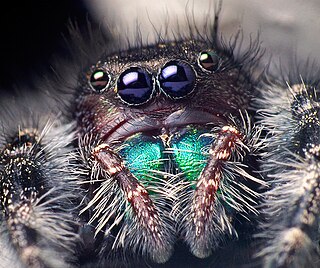
The Thomisidae are a family of spiders, including about 170 genera and over 2,100 species. The common name crab spider is often linked to species in this family, but is also applied loosely to many other families of spiders. Many members of this family are also known as flower spiders or flower crab spiders.

Wolf spiders are members of the family Lycosidae, named for their robust and agile hunting skills and excellent eyesight. They live mostly in solitude, hunt alone, and usually do not spin webs. Some are opportunistic hunters, pouncing upon prey as they find it or chasing it over short distances; others wait for passing prey in or near the mouth of a burrow. Wolf spiders resemble nursery web spiders, but wolf spiders carry their egg sacs by attaching them to their spinnerets, while the Pisauridae carry their egg sacs with their chelicerae and pedipalps. Two of the wolf spider's eight eyes are large and prominent; this distinguishes them from nursery web spiders, whose eyes are all of roughly equal size. This can also help distinguish them from the similar-looking grass spiders.

Ground spiders comprise Gnaphosidae, the seventh largest spider family with over 2,000 described species in over 100 genera distributed worldwide. There are 105 species known to central Europe, and common genera include Gnaphosa, Drassodes, Micaria, Cesonia, Zelotes and many others. They are closely related to Clubionidae. At present, no ground spiders are known to be seriously venomous to humans.

Dictynidae is a family of cribellate, hackled band-producing spiders first described by Octavius Pickard-Cambridge in 1871. Most build irregular webs on or near the ground, creating a tangle of silken fibers among several branches or stems of one plant.

Phidippus is a genus in the family Salticidae. Some of the largest jumping spiders inhabit this genus, and many species are characterized by their brilliant, iridescent green chelicerae. Phidippus is distributed almost exclusively in North America, with the exception of two exported species. As of January 2021, there were about 80 described species in the genus. Species previously described in Phidippus which are found in India and Bangladesh do not belong in this genus.

Stenaelurillus is a genus of jumping spiders that was first described by Eugène Louis Simon in 1886. Most species live in Africa, with some species found in Asia, including China. All species have two white longitudinal stripes on the carapace, and both sexes show strong bristles around the eyes. The name is a combination of the Greek sten- "narrow" and the salticid genus Aelurillus.

Thyene is a genus of jumping spiders that was first described by Eugène Louis Simon in 1885. It is a junior synonym of Mithion, and senior synonym of Brancus, Paramodunda and Gangus.

Agelena is a genus of agelenid spiders first described by Charles Athanase Walckenaer in 1805. Sometimes referred to as Eurasian grass spiders, they trap their prey by weaving entangling non-sticky funnel webs. They are limited to the Old World, occurring from Africa to Japan. Many species have been moved to other genera, particularly to Allagelena, Benoitia and Mistaria.

Hogna is a genus of wolf spiders with more than 200 described species. It is found on all continents except Antarctica.
Ludovico di Caporiacco was an Italian arachnologist.

Box kite spiders (Isoxya) is a genus of Afrotropical orb-weaver spiders first described by Eugène Simon in 1885. Like the spiny orb-weavers they have six prominent spines on their abdomen. They are small spiders, measuring 3 to 7 millimetres across. They have a sclerotised abdomen which is typical of the Gasteracanthinae.

Oxyopes is a genus of lynx spiders found worldwide. It includes arounds 300 species and is classified under the lynx spider family Oxyopidae. Like other lynx spiders, they are easily recognizable by the six larger eyes arranged hexagonally on top of the head (prosoma), with the remaining smaller two eyes in front. They are also characterized by long spine-like bristles (setae) on their legs. They are ambush predators, actively hunting prey by sight. Though they produce and use silk, they do not build webs to capture prey.

Synema is a genus of spider in the family Thomisidae, found in most parts of the world.
Synotaxus is a genus of araneomorph spiders in the family Synotaxidae that was first described by Eugène Louis Simon in 1895. Originally placed with the tangle web spiders, it was moved to the family Synotaxidae in 2017.

Langona minima is a species of jumping spider in the genus Langona that lives in Kenya. The spider was first described by Ludovico di Caporiacco in 1949. The female is typically 3.2 mm (0.13 in) long and generally brown. The species can be distinguished from other similar species by its copulatory organs, and particularly the triangular depression in its epigyne. The male has not been described.
Charminus is a genus of nursery web spiders that was first described by Tamerlan Thorell in 1899.
Heriaesynaema is a monotypic genus of African crab spiders containing the single species, Heriaesynaema flavipes. It was first described by Lodovico di Caporiacco in 1939, and is found in Ethiopia.

Aelurillus subaffinis is a species of jumping spider in the genus Aelurillus that lives in East Africa. It was first described in 1947 by Ludovico di Caporiacco based on a specimen that may have come from Tanzania. Only the female has been described. The spider is small. It has a dark brown carapace that is between 3.1 and 3.2 mm long and a yellow abdomen that has a length between 2.75 and 3.8 mm. It has brown chelicerae, a brown-yellow clypeus and yellow legs. The epigyne has a low pocket, distinctive shape and sclerotized flaps. It is similar to the related Aelurillus aeruginosus apart from the copulatory organs.

Xenoctenidae is a family of araneomorph spiders separated from Miturgidae in 2017.
Agelena incertissima is a species of spider in the family Agelenidae, which contains at least 1,350 species as of August 2021. It was first described by Caporiacco in 1940 and is native to Ethiopia.














